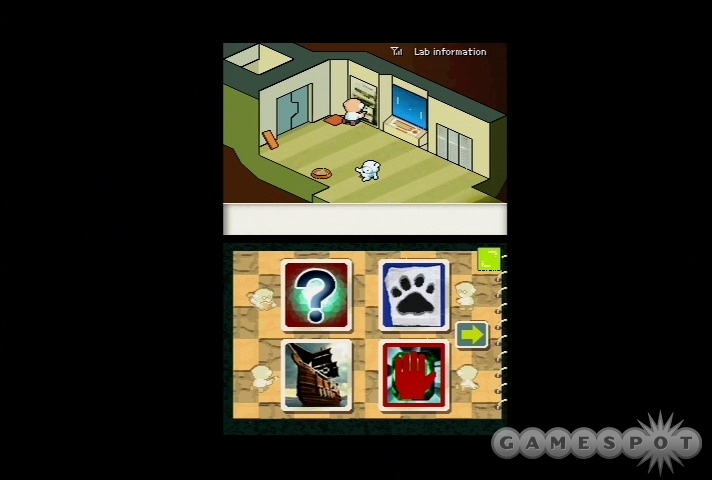Contact is a weird little adventure role-playing game in which you play as a boy recruited to help a pixelated scientist get his flying space lab back into working condition. It's got a good sense of humor and plenty of charm. Yet while the story can be interesting, the convoluted environments and simplistic, repetitive combat bog down a game that just scrapes by thanks to its quirky style.

At the beginning of Contact, you're introduced to the professor, who looks straight out of an old Nintendo game and seems like a nice-enough guy with a cute pet dog...that dreams of one day becoming a cat. You control a boy named Terry, whom the professor needs to gather some power cells that can get his space lab back up and running. The power cells have been scattered all around a tropical archipelago, and the space lab becomes a ship that can sail between these islands. So Terry must set out on foot to run the professor's errands, and he'll encounter all kinds of weird monsters, the military, and a rival band of adventurers called the CosmoNOTs in the process. Terry winds up going through the game's dungeonlike levels hacking and slashing away at monsters while solving some basic, sometimes annoying puzzles.
The initial weirdness of the premise quickly gives way to a straightforward dungeon crawl. Combat in Contact is purely stats-based, so all you really do is get close to a foe, hit the B button to enter into combat mode, and watch as Terry trades hits with the enemy until somebody runs out of health. You can use food and other items to restore your health, and you can learn a variety of special abilities, but the combat never really picks up. In fact, most combat can easily be avoided just by running straight past your foes. However, you'll come upon some unavoidable battles--basically boss fights--that you'll probably lose at least the first time, because you'll be too weak to win. You don't gain conventional experience points from defeating creatures in Contact, but you have a whole mess of combat-related statistics related to your health, your defense, and your strength that gradually go up as you fight. There's no real consequence for running out of health besides a trip straight back to the professor's lab, so gameplay often boils down to slogging through the same few screens' worth of enemies in an attempt to get stronger.
The game is somewhat nonlinear at first, but the ability to travel to a few different places and wander around the environments without much direction mostly just makes it harder to figure out what you're supposed to be doing. To the game's credit, there are a lot of different items to be found, including different outfits for Terry that change his appearance and give him new abilities. Some of these give him new skills, such as the ability to cook, fish, or pick locks, so finding each new outfit can be exciting. But then it's back to running around in the same set of areas, fighting the same creatures. You get a decent sense of Terry's increasing strength as he keeps on fighting, which is important to any role-playing game, but since the fighting and exploration isn't particularly involved, Contact can get dull.
It doesn't help that the presentation leaves a lot to be desired. The initially quirky charm of the visual style wears out its welcome, since you'll wind up fighting so many plain-looking creatures and Terry himself looks generic. The game doesn't do much with the two screens of the Nintendo DS, either, as the top screen is almost exclusively limited to showing you the professor dillydallying as you do his dirty work. You use the touch screen and other DS features in a few spots, such as for peeling off and slapping special decals onto the screen, but this might as well have been a Game Boy Advance game. Contact does have a few nice music tracks here and there, but a jarring transition to and from combat music is what sticks out. Sound effects are sparse but decent. There's no speech, though you hear a little vocal cue when some of the main characters talk, which helps give them a bit of personality. It helps that there's some nicely written dialogue, which is rarely flat-out funny, but often amusing. There's a creative edge to this game, such as how the instruction manual is presented as if it were the professor's personal Web log, complete with some emotional rants and pointless surveys.

Contact is pretty brief for an RPG, clocking in at around 10 or more hours, though it could take you longer if you get stuck. There's more stuff to explore after you've finished the main storyline (besides trying to wrap your head around the ending), such as trying to win over the hearts of several young ladies, but Contact doesn't offer much in the way of clear-cut replay value. The game does have some basic Wi-Fi support in the form of a system that lets you and other Contact players exchange friend codes so that you can visit a special island where you'll get to meet each other as non-player characters. That you can get some special items here is probably the most worthwhile thing about it.
Contact is either not quite fun enough or not quite weird enough. Its strangest ideas are introduced at the beginning and reconciled at the end, to a certain extent. But in the middle, you get a basic adventure role-playing game that'll make you forget about the game's oddball style and good writing. This turns out to be part of the point, but that point may get lost in the shuffle because the underlying game doesn't have more to offer.



